SMAP

Smap Cooking show SMAP is the most enduring of Japan's all-boy, “tarento” idol group. Founded in 1991, when the youngest member was 14, the five-member group began as a skateboarding back up group for the teen idol Hikaru Genji before breaking out on their own. SMAP originally had a sixth member but he left the group to become a motorcycle racer.
SMAP was still going strong in the late 2000s and no doubt have set some record for television exposure. They are everywhere. The have had a number of hit songs and make round in musical variety shows. They have appeared in a number of dramas and have had their own cooking shows. The cutest members — particularly Takuya Kimura, a national heartthrob — have released solo songs, hosted television shows and done their own commercials. The least attractive members have pursued roles in serious dramas.
Once a ANA flight ready to take off in Hokkaido was tuned back and went pack to the terminal after it was discovered that two members of the SMAP entourage had inadvertently been left behind
In September 2011, the Japanese pop group SMAP staged their first overseas concert in Beijing on Friday, performing various numbers that included Chinese-language versions of some of their hit songs in front of an audience of about 40,000. The concert program included Chinese versions of "Sekai ni Hitotsu Dake no Hana" (The only flower in the world) and "Yozora no Muko" (Over the night sky). After arriving in Beijing, the group received VIP treatment from the Chinese government. They were allowed to hold a press conference at the Great Hall of the People. [Source: Seima Oki, Yomiuri Shimbun, September 18, 2011]
SMAP initially planned to hold concerts in China in 2010 and perform at Expo 2010 in Shanghai . However, they were forced to postpone them for various reasons, including a souring of Japan-China relations after an incident in which a Chinese fishing boat collided with Japan Coast Guard vessels near the Senkaku Islands. Later the pop group serenaded Chinese leader Wen Jiabao he visited Japan in May 2011. SMAP sang one of their hit songs in Chinese. SMAP is scheduled to perform in Beijing — its first overseas concert — in September 2011.
J-Pop Websites and Resources
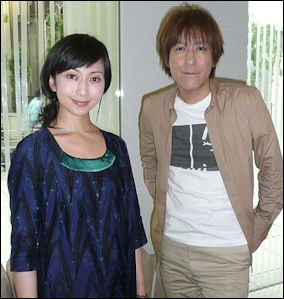
Every-Little-Thing Good Websites and Sources: Oricon Style (Japanese language site) http://www.oricon.co.jp/ oricon.co.jp ; Essay on J-Pop and Hip Hop aboutjapan.japansociety.org ;
J-Music.com j-music.com ; Recording Industry Association of Japan riaj.or.jp ; Japan Zone on Popular Music in Japan japan-zone.com J-Pop Etcetera j-music.com/jpop ; Japanese, Chinese and Korean CDs and DVDs at Yes Asia yesasia.com ; Japanese, Chinese and Korean CDs and DVDs at Zoom Movie zoommovie.com ; CD Japan cdjapan.co.jp ; J Pop Asia jpopasia.com ; J-Pop Music Station lava.net/~raistlin ; J-Pop Bulletin Board jpopmusic.com ; J-Pop Artists : Namie Amuro namienewsnetwork.blogspot.com ; Morning Musume momusu.hatsukoi.org ; Hikaru Utada official site utada.com ;Ayumi Hamasaki official site avexnet.or.jp/ayu ; AKB48 akb48.co.jp ;Kumi Koda rhythmzone.net/koda ; Wikipedia article on Smap Wikipedia ; Arashi Pictures and Nothing Else livejournal.com/arashi_daily ;
![]()
Utada Hikaru Links in this Website: CLASSICAL JAPANESE MUSIC Factsanddetails.com/Japan ; WESTERN CLASSICAL MUSIC IN JAPAN Factsanddetails.com/Japan ; JAPANESE FOLK MUSIC AND ENKA Factsanddetails.com/Japan ; J-POP AND POP MUSIC IN JAPAN Factsanddetails.com/Japan ; J-POP AND POP ARTISTS IN JAPAN Factsanddetails.com/Japan ; ROCK IN JAPAN Factsanddetails.com/Japan ; PUNK, FOREIGN MUSIC, HIP-HOP IN JAPAN Factsanddetails.com/Japan ; YOKO ONO Factsanddetails.com/Japan ; KARAOKE IN JAPAN Factsanddetails.com/Japan ; DANCE IN JAPAN Factsanddetails.com/Japan
Good Websites and Sources on Japanese Music: “The Rough Guide to the Music of Japan” is a CD assembled by Paul Fisher, Short Introduction to Japanese Music asnic.utexas.edu ; Bibliography on Music in Japan aboutjapan.japansociety.org ;Traditional Japanese Music and Dance sfusd.k12.ca.us/schwww ; Wikipedia article on Music of Japan Wikipedia ; Performing Arts Network of Japan performingarts.jp ; Traditional Performing Arts in Japan kanzaki.com ; Hear Music, a World Music Store with a hearjapan.com ; Japanese, Chinese and Korean CDs and DVDs at Yes Asia yesasia.com ; Japanese, Chinese and Korean CDs and DVDs at Zoom Movie zoommovie.com
SMAP Member Naked in a Park
In April 2009, SMAP member Tsuyoshi Kusanagi was arrested for running around naked in a Tokyo park at 3:00am after a bout of heavy drinking. He resisted arrest and had be rolled up in a vinyl sheet and bundled into the police car. While he was being arrested he said,. “What’s wrong with being naked?”
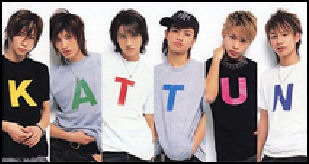
Katun, popular in mid 2000s Kusanagi said he had been warned by other SMAP members that his drinking was a problem He lost millions of yen in endorsements and appearances and commercials with him were pulled off the air He appeared at several press conference to apologize and was back on the air about a month after the incident. Prosecutors decided not to indict him for public indecency.
On the night of the incident police arrived at the park after someone called in a complaint about a noisy drunkard. When police arrived they found Kusanagi sitting naked and cross-legged in the grass, shouting at the top of his lungs. Breath test showed he had a 0.8 milligrams of alcohol per liter in his blood (a person can be arrested for drunk driving with 0.15 milligrams of alcohol per liter). Kusanagi later he said he didn’t; remember why he took his clothes off and had little recollection of the night in which he spent six hours in two izakaya and drank more than ten large glasses of beer and sochu and ice.
Other Boy Groups in Japan
Kinki Kids is a popular, cute boy duo (Koichi Domoto and Tsuyoshi Domoto) that appear regularly in commercials and on variety shows. They also earned a spot in the Guinness Book of World Records by launching their musical career with 13 straight No. 1 singles. Even The Beatles never accomplished that. The Kinki Kids got their start as back up singers for SMAP.
Arashi is very popular in Asia. In 2010 they were selected as goodwill ambassadors by the Japan Tourism Agency. In 2011 they were used in a promotion video released in 133 countries that urged visitors to come to Japan and assured them that Japan was safe to visit after the March 2011 earthquake and tsunami and the Fukushima nuclear power plant disaster.
Namie Amuro

late Namie Amuro The most popular idol singer of the mid 1990s was Namie Amuro, a teen-age sensation from Okinawa who made her solo debut after finishing her training at the icon factory Okinawa Actor's School (OAS, J-Pop section) in 1992 and breaking up with her group the Super Monkeys.
Amuro had sold more than 12.5 million albums and 15.8 million singles by 2000 and had hits with the songs “Try Me, Don't Wanna Cry, Body Feels Exit” and “Can You Celebrate”. Her CD Sweet 19 Blues sold 3.7 million copies in two months. She appeared regularly on Japanese dramas and children's shows. In 1996, she became the youngest artist in history to be presented with the Japan Record Award's Committee's Best Artist Award.
In the summer of 1998, the 20-year-old Amuro shocked her fans when she announced she was pregnant, had quietly married Masaharu Maruyama and was taking a few months off. The ponytailed Maruyama was 15 years older than Amuro. A professional dancer from a family of doctors, he usually goes by the name of Sam and was Amuro's dance teacher at OAS.
In 2000, Amuro performed in front of U.S. President Bill Clinton and other world leaders at G-8 summit in Okinawa. In 2001, there was some talk that she might move to the United States and work with the producer for TLC.
Namie Amuromania
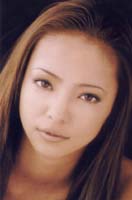
early Namie Amuro In the mid 1990s, hundreds of thousands, perhaps millions, of young Japanese schoolgirls imitated Amuro's look: long brown-streaked hair, thinly-drawn arched eyebrows, hot pants and knee-high boots. She also helped set in motion a teenagers obsession for tanned skin.
Women magazines gave countless tips on how to achieve the Amuro look and one cosmetic company cashed in on the Amuro craze by selling 600,000 templates that allowed fans to pencil in Amuro-style eyebrows. When Amuro cut off her hair in 1998 it was front-page news.
After she had her baby, one Japanese company released an electronic game in which players raised a virtual infant who was a playmate of Amuro's child.
In March 1999, Amuro's mother was murdered by a debt-ridden family friend who was angry that she wouldn't lend him money. The killer, Namie Amuro's mother’s brother-in-law, ran over her repeatedly with his car and attacked her with a hatchet and the drove his car three miles away and committed suicide.
Namie Amuro won MTV Video Music Awards in 2009 with “ New Look” winning Best Female Video and “ Sexy Girl” taking the award for Best R&B Video.
Digital Girl
Another big pop star in the mid-1990s was DK-96, a computer-generated idol singer whose initials stood for Date Kyoko, a typical Japanese name. Created by Hor Productions, she was 17-years old and 5-foot-four; had long legs, firm breasts and round eyes; wore a halter top, hot pants and space-age thick-soled sneakers; and had a really cute boyfriend. Her father sold sushi outside a U.S. military base.
DK-96's first single "Love Communication" was a big hit; magazines and television stations fell over themselves to be granted interviews; and at least 15 companies signed her ups to do endorsements.
DK-96's younger sister played soccer in grade school, her first love was an older boy on her team, and she enjoyed collecting sneakers, studying foreign languages and practicing boxing to help her with her dancing.
Dreams Come True
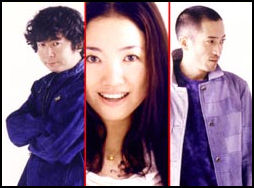
Dreams Come True, a light-jazz-soul pop band, has sold more than 25 million albums, mostly in Japan and Asia.
Dreams Come True was formed in 1988 by singer Miwa Yoshida, bassist Masato Nakamura and keyboardist Takahiro Nishikawa, a friend of Yoshida's from high school. After causing a stir in the Tokyo club scene, the group recorded an album that sold more than 1 million copies. Their 1992 album “The Swinging Star” became the first Japanese album to sell more than 3 million copies. In 1994, they wrote and recorded the themes song for that animated Hollywood film “The Swan Princess”.
Dreams Come True has worked hard to find an audience in the United States and Europe but so far they haven't found one. Washington Post rock critic Mark Jenkins wrote that although their songs are "brisk and tuneful" their music "aspires to the depth of advertising jingles."
Dreams-Come-True keyboardist Takahiro Nishikawa was arrested twice for drugs, in 2002 and 2006, for possession of stimulants and was kicked out of the group.
Tetsuya Komura, Hitmaker Charged with Fraud

Tetsuya Komura was the leader of the popular group Globe and a producer and songwriter of a number of hits in the 1990s and 2000s. For a while he was regarded as one of Japan’s biggest taxpayers (a measure of wealth in Japan), paying as much as ¥1 billion a year and once selling 5 million copies of a CD in less than 50 days. At the height of his fame he was known for his extravagant lifestyle, doing things like booking all the first class seats on international flights and reserving entire floors of expensive suites at luxury hotels for his entourage.
In the 2000s Komura began having money problems. Investments and projects like a music company in Hong Kong, a J-League soccer team and clothing line promoted by Brad Pitt went bust. In 2006, he filed for arbitration in a Tokyo family Court, requesting a reduction in the ¥780 million divorce settlements he was ordered to pay his former wife on the grounds he was on the verge of a financial crisis. His troubles coincided with a decline in his popularity. A CD he produced in 2008 for his wife Keiko, the vocalist in Globe, sold less than 20,000 copies.
Despite all this he continued with his extravagant lifestyle,. The rent ion Tokyo apartment was ¥2.8 million a month. His credit card bills were often in the tens of millions of yen.
In November 2008 Komuro was charged with fraud for selling his the rights to 806 of his songs for $50 million to a company president even though he already sold the rights to most of the songs to music publishers. Komuro paid the money back plus an extra $1.5 million compensation and interest with money lent him by the Masato Matsura, President f the Avex music group.
In January 2009, Komuro admitted fruad in court, He said that he earned about $500,000 a year from royalties from his songs but owed more than ¥2 billion to his former wife, financial institutions and other. In May 2009, he was given a suspended sentence in part because he repaid the money.
Morning Musume
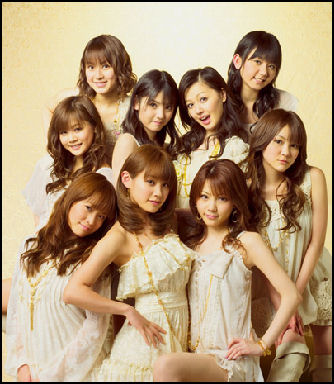
Morning Musume ("Morning Girls") were a song-and-dance J-pop group that were all over the place in the late 1990s and early 2000s despite the fact the had virtually no talent and can’t keep rhythm when they dance. They were particularly a favorite among prepubescent girls who shelled millions for Morning Musume recordings, cards and other merchandise
Named after a breakfast set at a restaurant, Morning Musume was created by a media manipulator and producer, known by the single name of Tsunku, from a bunch of girls who failed an audition for talent search to find a new pop idol. In their biggest hit, “Love Machine”, they wore belly-dancing out fits and shouted the chorus "Bon Ba Ba Bon" and "Wow wow wow wow." Tsunku writes most of their songs and incorporates everything from British soccer chants to Bollywood jingles into them.
By 2001 Morning Musume had grown to 14 members, age 12 to 22, and embraced a number of spinoff groups like Country Musume, Tanpopo, Minimoni.and Petiot Mone. Each song had its only silly set of costumes, a hooting chorus and unsynchronized dance routines. They stared in their own movies and became such a fixture of evening television in Japan it was difficult to surf through the channels and not find them on at least one channel. Their producer made most of the money.
Morning Musume constantly changed its line up. There was even a television show that followed the ups and downs of the members and who was in and who was out. One of the early members of the group, Maki Goto, was one of the youngest when she joined at the age of 13 in 1999. By 2001 when she was 15 she had become a senior member. In 2002, the group had 13 members, including two middle school students. Each member made an average of $1.3 million a year. By 2003, 44 girls had been members of Morning Musume or Morning Musume spin-offs.
Hikaru Utada and Ayumi Hamasaki
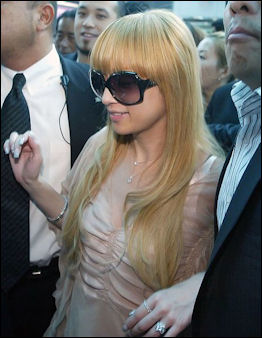
Ayumi Hamasaki Hikaru Utada's album “First Love” broke the record for best selling album. It sold over 8 million copies and include dance grooves like “Automatic” and “Moving You”. Utada was 16 when the album was released. As of 2003, it was still the best selling album in Japan ever.
Utada was born in New York. She is the daughter of a record producer and the singer Keoko Fujim who was popular in the 1970s. She grew up hanging out in recording studios with her father, who encouraged her to begin writing her own song when she was 10. She recorded her first song in New York when she was 14 under the alias Cubic U.
Utada's second album “Distance” also sold millions of copies. By that time she was a student at Columbia University in New York. In 2004, she released the English-language CD “Exodud” which sold over a million copies in Japan but went absolutely nowhere in the United States.
Ayumi Hamasaki was the most popular singer in the early 2000s, earning about $6 million 2001 alone. She had a number of hit songs, sold millions of singles and set in motion many fashion trends embraced by young women such as wearing camouflage shirts and decorating her finger nails with feathers and spots. She was paid big money to do commercials for Panasonic, Boss coffee drinks and one of Japan's largest cell phone companies.
Hamasaki sings in a ballady J-pop style but receives some kudos for writing her own lyrics, which have described at thoughtful and introspective. She was the top money earner among singers in 2001 and 2002. By the late 2000s, she was regarded as Japan’s top-selling singer, with 29 No. 1 hits and sales of more than 50 million record.
In 2008, Hamasaki revealed that she has gone deaf in her left ear. She first notices the problem, which may have been caused by noise and is inoperable, in 2000. She thought her condition would improve but it didn’t. Now she is completely dead in the one era. Even so she continues to go on with here singing career.
In January 2011, 32-year-old Ayumi Hamasaki married 30-year-old Manual Schwartz, an Austrian actor who played the role of her husband in a 2010 promotional video, at a church in Las Vegas in a small Vegas-style ceremony attended by 10 friends. “The husband is now a real husband starting this year,” Ayu announced on Twitter. Just a few days before she appeared on the annual New Year’s Eve Red and White show wearing a pristine white weeding gown for her performance of the song “ Virgin Road “.
Hamasake debuted as in the last 1990s after a modeling and acting stint. She quickly rose to stardom and was particularly embraced by young women. She was at her peak in the early 2000s when won the Japan Record Award for three consecutive years, from 2001 to 2003 with her megahits “ Dearest “, “ Voyage “ and “ No Way to say “.
Popular Groups from Okinawa
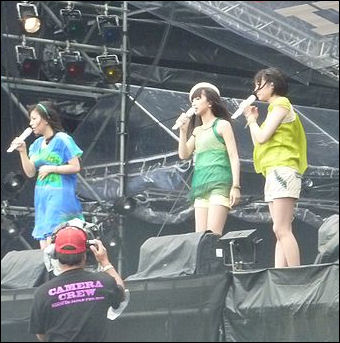
Perfume Namie Amuro is the most well known artist from Okinawa. Other popular artist in the late 1990s and early 2000s included MAX, SPEED and Da Pump. MAX is a four girl song-and-dance group created from what was left of the Super Monkeys after Namie Amuro left. MAX stand for "Music Active eXperience," a nod to their energetic dance routines tat involves cartwheels and backflips. They had hits with the songs “Give Me a Shake, Get My Love” and “Kiss Me Kiss me Baby”
SPEED was girl song-and-dance group made of OAS graduates — Hiroko, Hitoe, Erko and Takako — who were between the ages of 12 and 15 when the group started out. They had hits with “Body & Soul” in 1996 and “Go! Go! Heaven” in 1997. In 1998 they were recruited as poster girls for Pizza Hut, appeared ins a science fiction film with Da Pump and then broke up. Hiroko tried to make it as a solo act. The group reformed in the late 2000s.
Da Pump is an all-boy song-and-dance group created by OAS. The rap on them was they couldn't sing but they sure could dance. When they began performing regularly on television it was revealed they could do a few flashy break moves but for the most were just as lousy dancers as singers. That didn't stop them however, from selling millions of records and attracting legion of teenage female admirers.
Top J-Pop Groups in the Mid 2000s

Exile Avex was the biggest independent label in the 2000s. Many of Japan’s most popular artists were with the label They included Ayumi Hamasaki, TRF, Do As Infinity, BoA, Hitomi. Kumi Koda, Ami Suzuki, Every Little Thing and Dream. BoA is South Korean who started performing when she was a young teenager and has been called the Britney Spears of Asia. Many of these acts appeared together in the “A-Nation” tour
The top J-Pop groups in 2004 and 2005 included the ballad singer Ken Hirai and Orange Range, a light hip hop group from Okinawa who had a big hit with Locolotion, which incorporated elements of the American disco-era hot Locomotion. Mr. Children, Exile, Def Tech and Nana were also popular. Mr. Children won MTV Video Music Awards in 2009 for Best Album of the Year for “ Supermarket Fantasy” .
As of 2012, Orange Range, then regarded as an alternative rock-hip-hop band', has been together for more than a decade and churned out a number of hits. Based in Okinawa, the band had sold about 13 million CDs and DVDs as of 2012, , bolstered by such hits over the years as "Locolotion" and "Hana" (flower). Many of the band's songs have been used in commercials and TV dramas. [Source: Jin Kiyokawa, Yomiuri Shimbun, May 18, 2012]
“Looking back on the 10 years since Orange Range released its first CD, Naoto, the band’s leader, is pleased with how the band has progressed. "[We worked with a major record company for most of those years] and made some hits," he said. "Maybe that's why we can do what we want now. It has been an amazing 10 years.”
“Naoto is an unabashed fan of Denki Groove, and says the Japanese technopop group has heavily influenced his own music. "My favorite artist changes according to my mood, but Denki Groove always ranks second," he said. Orange Range's members--Naoto, Yoh, Hiroki, Yamato and Ryo--are all in still in their 20s in 2012.
Top J-Pop Groups in the Late 2000s
Exile dominated the MTV Video Music Awards in 2009. It won best song “ Ti Am” (“Chapter Two”), best group video and best video awards. Exile has 14 members: two main singers and 12 dancers. In 2008. They were the top-selling artist in Japan and had three albums that placed in the to 10. The group earned almost $200 million and was among the most favored artist for cell phone ring tones. Exile won the award for Best Group video at the 2007 MTV Video Music Awards Japan.
Kumi Koda — a sort of Japanese version of Beyonce or Christina Aguilera with a nice body but not so great looks — was the hottest J-Pop star in 2005 and 2006. The granddaughter of a shakuhachi master, she was born in Kyoto in 1982 and was discovered in here second year of high school when she placed second out of 120,000 entrants in Avex’s “Dream Audition” — a nationwide talent search. She is pretty good dancer and singer and has some charisma on stage. Koda was a big winner at the 2007 MTV Video Music Awards Japan, winning three awards, including Best Female Video, Most Stylish Artist and Best Video. She also won three awards in 2006.
The boy idol group KAT-TUN was the hottest group in 2006 and 2007. Members of KAT-TUN’shuji to Akira — had the bestselling single in 2005. Another all male group, called Acqua — made up of “hosts” at the branches of the Acqua host club in Tokyo and Osaka — had a downloaded singles hit with their debut sing Misogi.
Other popular artists include Pornograffitti, made up of vocalist Akihito Okano and guitarist Haruichi Shind; e Kobukuro. Whose “All Singles Best” topped the charts in 2007; Ai who won two awards — the award for Best R&B video and Best Video for a film — at the 2007 MTV Video Music Awards Japan; and comic artist DJ Ozma, who won two awards — the award for Best Dance video and Best Male for a film — for his novelty track “ Age Every Kishi” at the 2007 MTV Video Music Awards Japan.
Ren-chan, a maid café singer-dancer, is popular among the otaku set.
Popular J-Pop Artists in 2010 and 2011
Soil & Pimp Sessions, MASH, YUI, Superfly and Juju were popular artists in 2011. YUI, a who turned 24 in 2011, is a pretty singer-songwriter who performed on the streets early in her career. She has a large following in Hong Kong, where she has twp platinum albums and 750,000 song downloads as of May 2011.
The pop band Kishidan appeared on a television dressed in Nazi SS uniforms. Afterwards management apologized for “distress it caused the Simon Wiesenthal Center.” The whole thing — including the apology — seemed carefully planned to draw publicity. The six-boy group usually dress up in the style of bosozuku motorcycle gangs.
The five-man pop idol group Arashi and all the female pop idol group AKB48 were the top artists in 2010. They took every slot in the software-ranked top 10 bestselling singles of 2010, according to information provider Oricon Co. AKB48 had four titles in the top 10, including the CD “ Beginner “, which sold 950,000 copies, while Arashi took the remaining six places. Sales by enthusiastic fans have been the driving force behind the success of both groups. In some cases fans bought multiple copies of the same CD so they could get an opportunity to shake hands with members of the groups at special events. As a further measure of their success Arashi and AKB48 headlined the New Year’s Eve white and red songfest.
As for 2011 the Yomiuri Shimbun reported: The year 2011 was remembered for the continued popularity of idol groups, especially AKB48 and K-Pop groups including KARA, Shojo Jidai and Tohoshinki. They became popular in 2010 and enjoyed higher singles sales in 2011. In the J-Pop category, AKB48 occupied first through fifth in CD single sales on the yearly Oricon chart with "Flying Get" ranking first at 1.59 million sold. Idol group Arashi sold 908,000 copies of Beautiful World to rank first in album sales. As for overseas artists, Lady Gaga was outstanding. She visited Japan in June to show her support after the March quake and tsunami and offered support through charitable activities.[Source: Yomiuri Shimbun, December 30, 2011]
In November 2011, Kyodo reported: Sales of the AKB48's CD single, "Kaze wa Fuiteiru," a song intended to cheer up people affected by the March 11 disasters, topped 1 million — the all-girl band's third consecutive CD to do so — in the first week after its release. Music information service company Oricon Inc. said that "Kaze wa Fuiteiru" ("A Wind is Blowing"), the group's 23rd single, registered sales of 1.3 million copies after it was released Oct. 26.The feat followed the songs "Flying Get," which sold 1.35 million copies, and "Everyday, Kachusha," which logged 1.33 million sales.The three CDs are the only ones out of all albums and singles sold in Japan this year to top 1 million in sales. [Source: Kyodo, November 2, 2011]
In the late 2000s, the pop idol group AKB48 was popular. Made up of cute girls in their late teens and early 20s with questionable talent, the group has performed in live in New York, where they also made a video in Central Park, and did their hit “Namida Sapuraizu!” (“Tearful Surprise”) at the Japan Expo in Paris.
Pop Music Scene in Japan in 2012
In a review of pop music in 2012, the Yomiuri Shimbun reported: “In the idol realm, AKB48 maintained its near stranglehold on the nation's pop scene, while other big musicians relied on "best of" albums to keep fans coming back. According to the Recording Industry Association of Japan, about 175 million CDs and other recorded audio products were produced as of the end of October, a 10 percent increase from the same period last year. These products are valued at 178.5 billion yen, a 7 percent increase, indicating that CDs will see their first year of growth after 14 years of decline. [Source: Yomiuri Shimbun, December 28, 2012]
First and foremost, each CD released by AKB48 sold more than 1 million copies. Products of affiliated groups--SKE48, NMB48 and new "authorized rival" Nogizaka46--also sold well. Momoiro Clover Z became the next hot all-girl group, reinforcing the genre's dominance in the music industry. This year saw less activity by South Korean artists in Japan compared to last year.
In album sales, Mr. Children's two albums occupied the first and second spots. Next on the list were one by AKB48, one by Arashi and one by Exile/Exile Atsushi. Albums from big-name artists Keisuke Kuwata, Tatsuro Yamashita and Yumi Matsutoya also sold well. Notable new faces were Kyary Pamyu Pamyu, Golden Bomber, Naoto Inti Raymi, and Sekai no Owari. All are known for flashiness and highly entertaining live shows. Their music-plus-something-extra is probably a reason behind their success.
Image Sources: Japan Zone, Wiki Commons
Text Sources: New York Times, Washington Post, Los Angeles Times, Daily Yomiuri, Times of London, Japan National Tourist Organization (JNTO), National Geographic, The New Yorker, Time, Newsweek, Reuters, AP, Lonely Planet Guides, Compton’s Encyclopedia and various books and other publications.
Last updated January 2013
